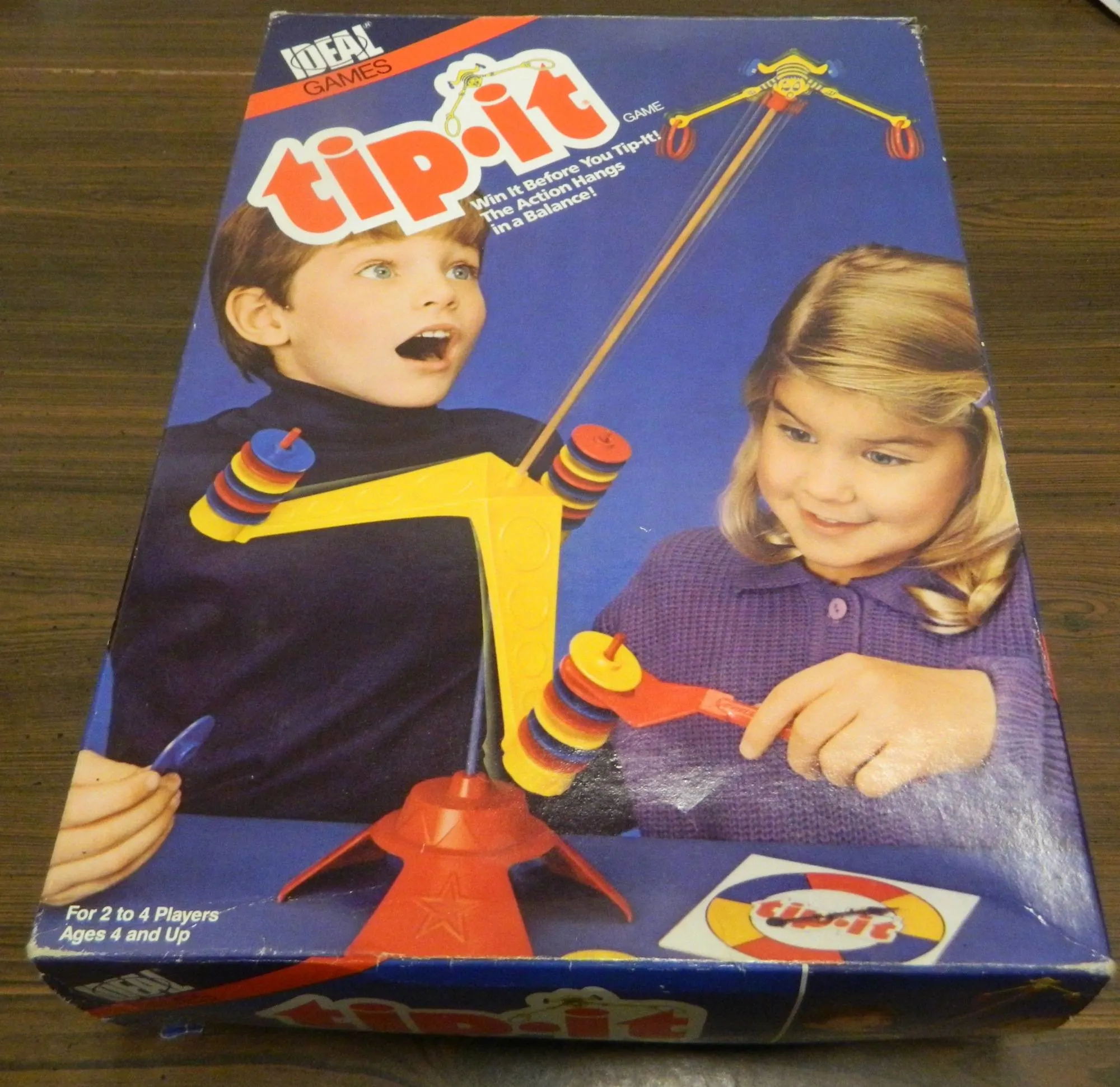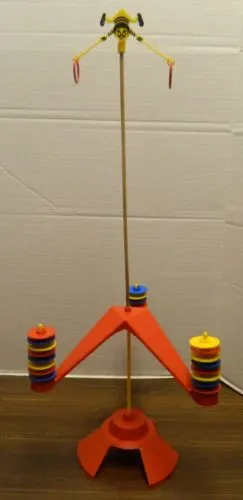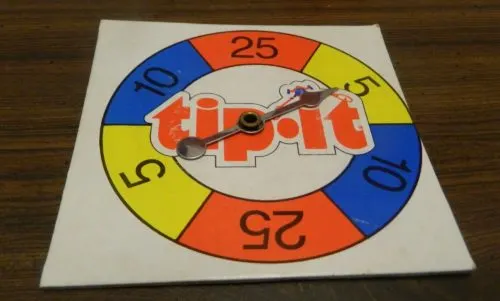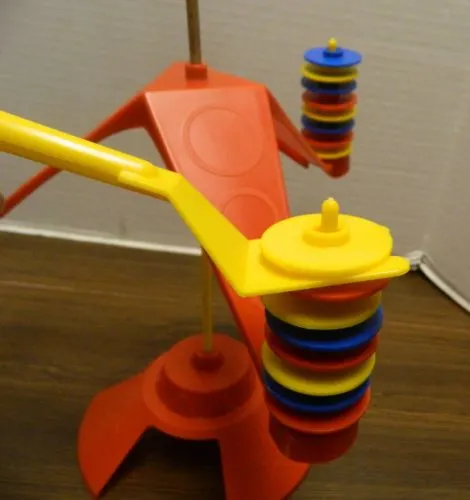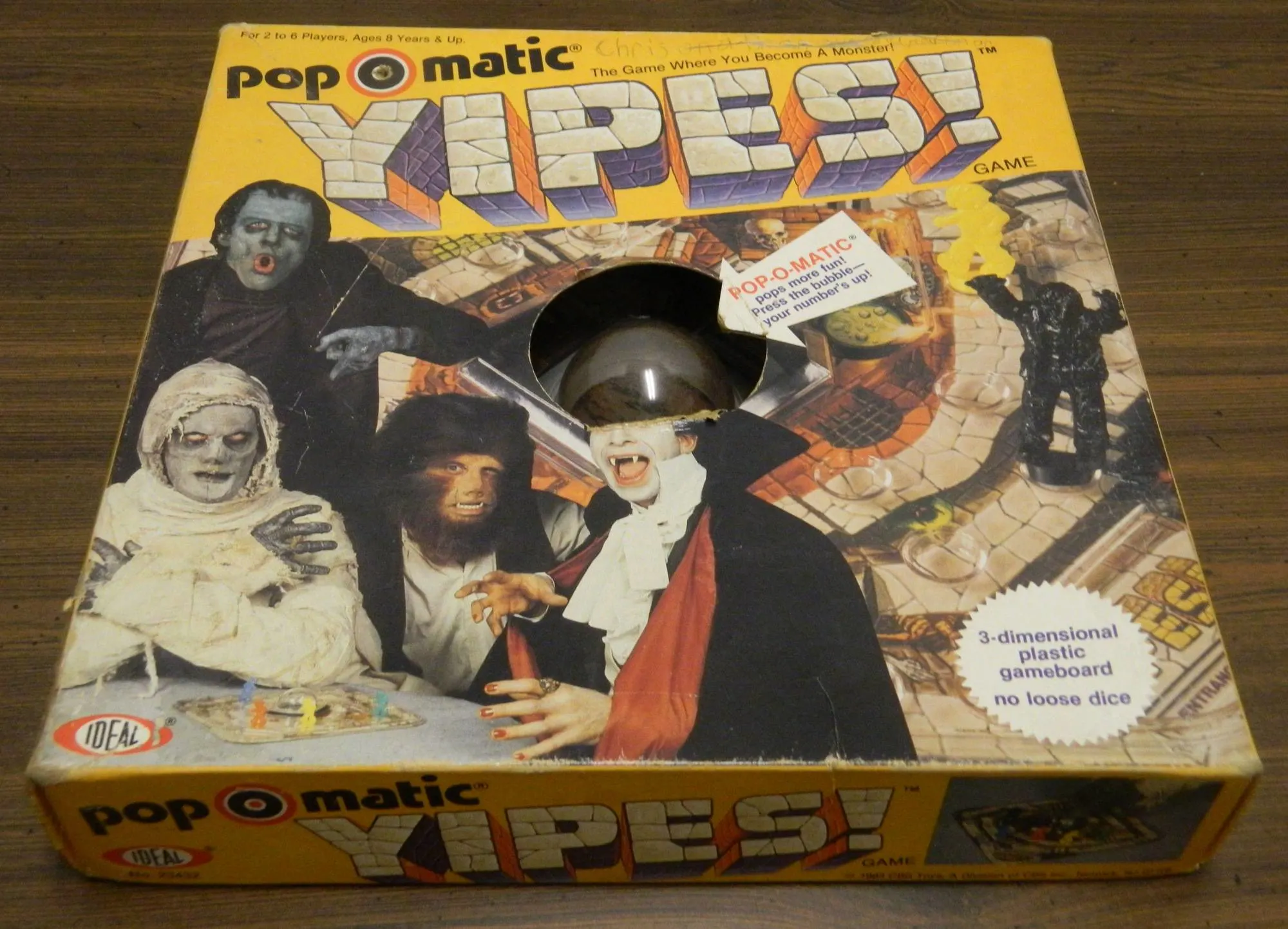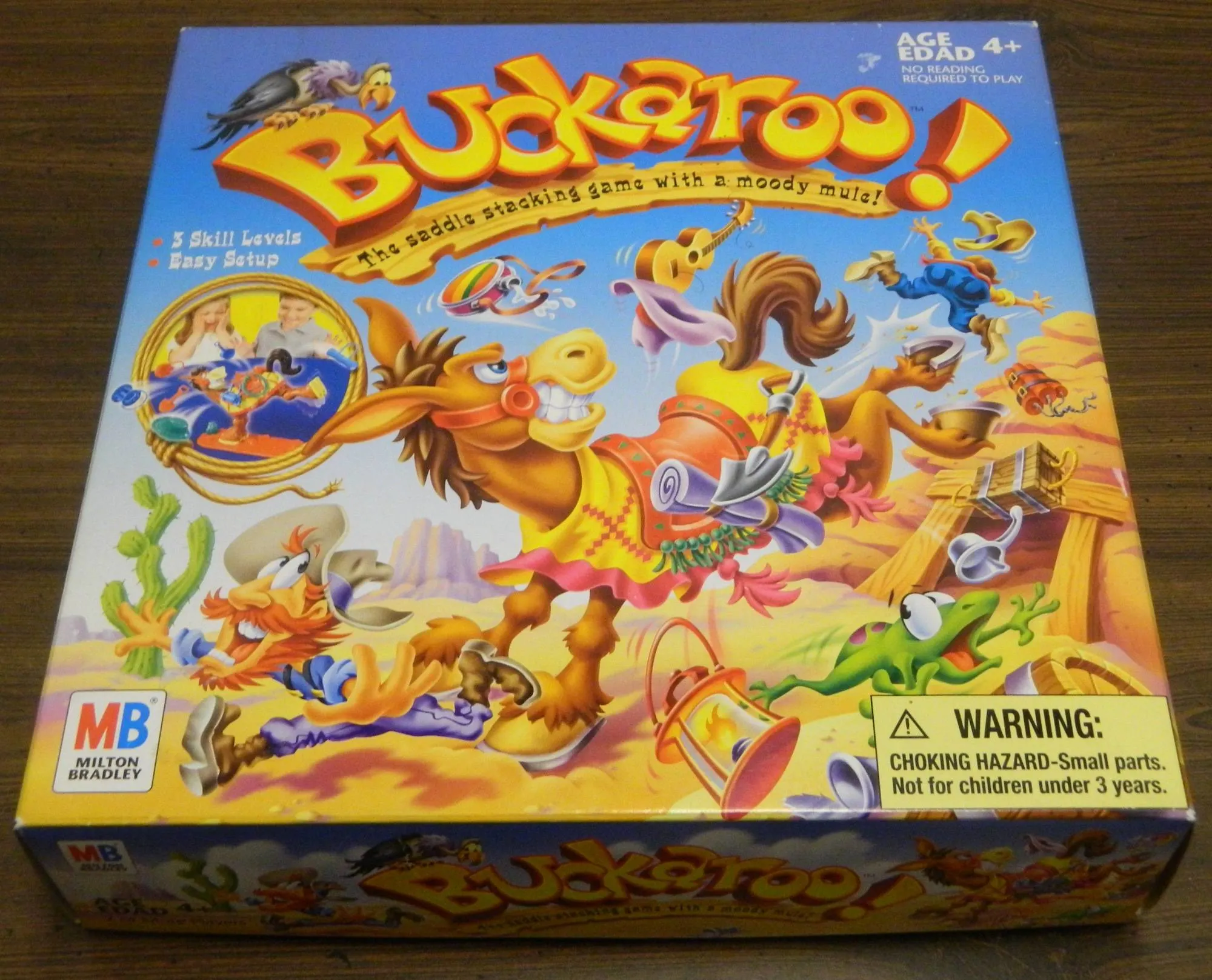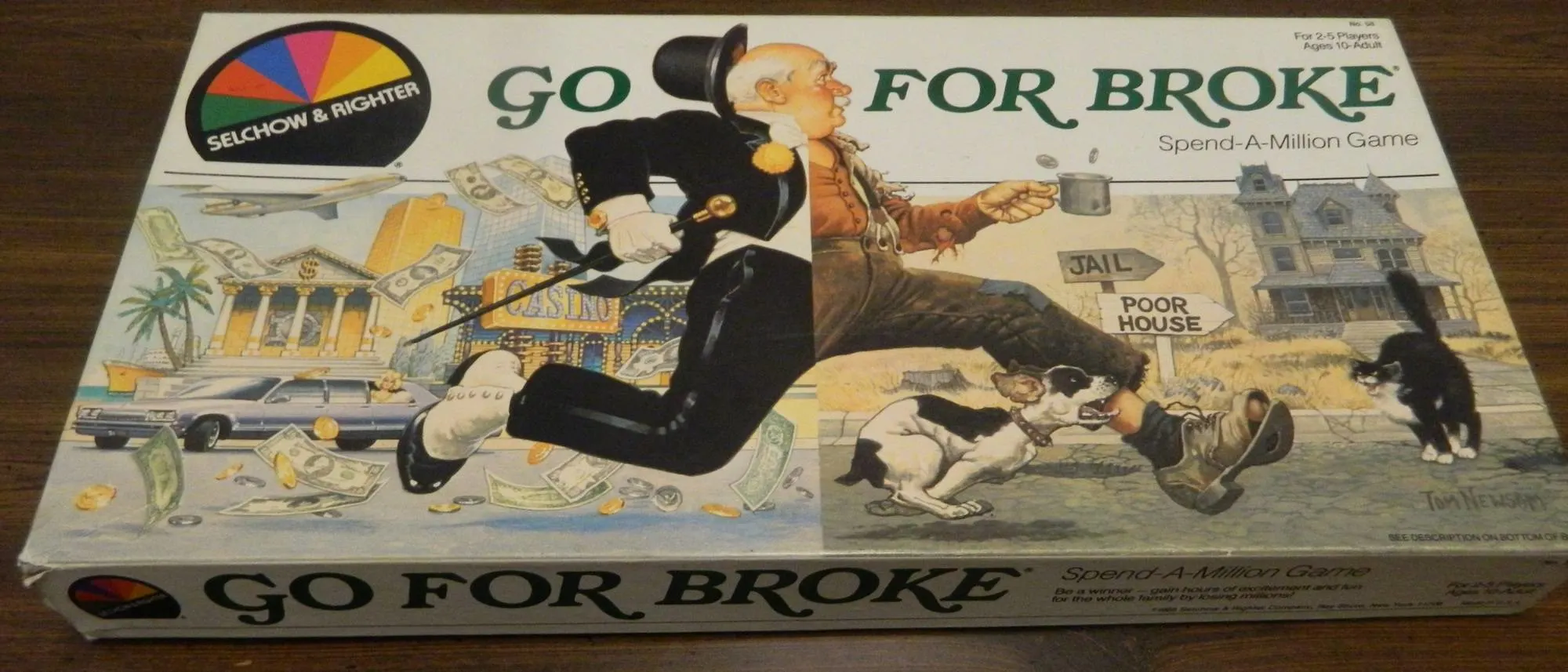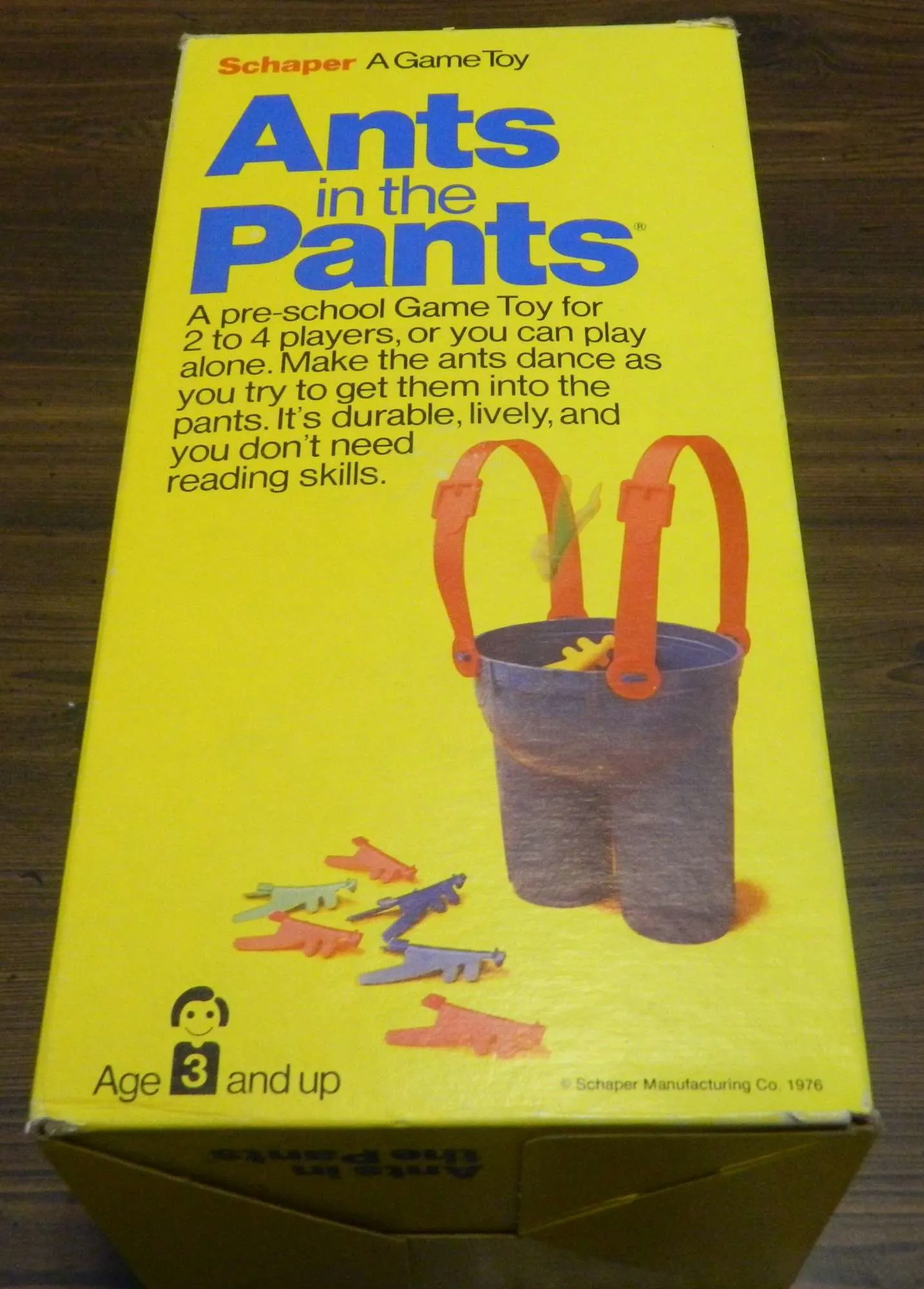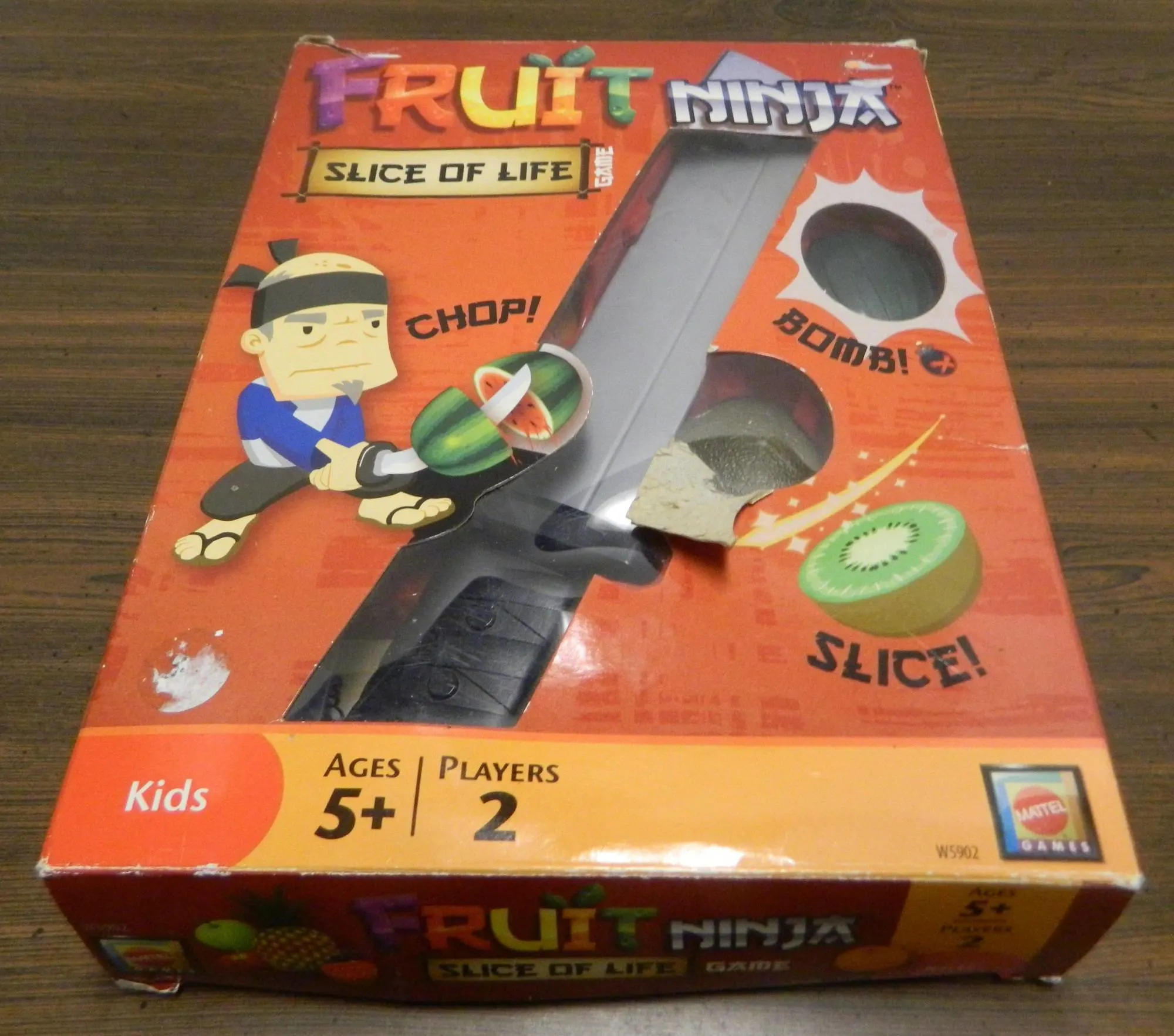I will admit that the dexterity/stacking genre is not one of my favorite genres of board games. There is nothing wrong with the premise behind stacking games as you can have fun with them. The problem I have with stacking games is the fact that almost all of the games feel exactly the same. If you have played one stacking game it feels like you have played all of them. This is one of the reasons I am always leery about playing a new stacking game. Today though I am looking at one of the oldest stacking games Tip-It. Having been first created in 1965 and still in production today I had hopes for Tip-It since there has to be some reason why the game has been in production for over 50 years. I will say that Tip-It is better than a lot of stacking games but it still has many of the same problems that plague most stacking games.
How to Play Tip-It
Setup
Place the base on the table and insert the shorter stick into it. Then balance the second platform on top of that stick. Place the three shortest sticks in the three holes of the second platform. Insert the longest stick into the second platform and place the acrobat on top of that stick. Place the discs on the sticks in the second platform making sure that the colors alternate. If you want to make the game more difficult adjust the gravity ring towards the top of the longer stick.
Playing the Game
A player begins their turn by spinning the spinner. If the spinner lands on a color, the player has to remove a disc of that color from the platform.
To remove the disc the player has to use the included fork.
If a player spins a color and that color is not on the top of any stack, a player has to move the discs that are on top of that colored disc to another stack. The player can then remove the colored disc that they spun.
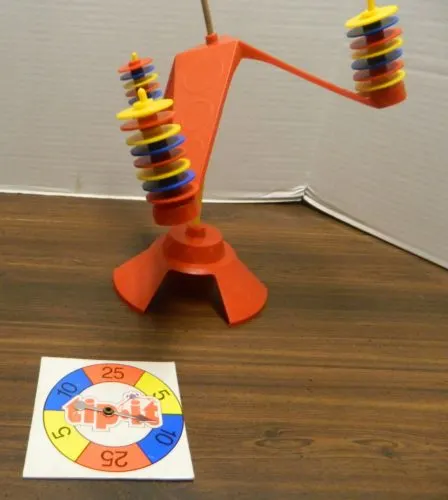
This player has spun blue but there are no blue discs at the top of any of the stacks. The player will have to move one of the discs from one stack to another in order to remove the blue disc.
If a player spins a color and none of that color is still on the platform, the player doesn’t remove any discs on their turn.
Some versions of Tip-It include two special sections on the spinner. One section forces a player to put one of the discs they have already collected back onto the platform. The other section makes the player lose their turn.
End of Game
The end game for Tip-It seems to have changed throughout the years. In most versions of the game the player who knocks off the acrobat is eliminated from the game.
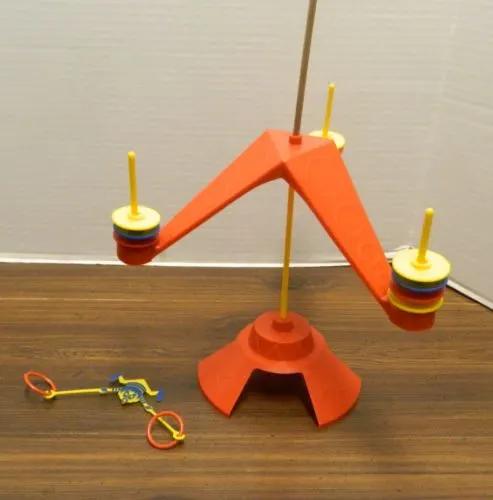
The acrobat has fallen off. The game has ended with the player who knocked off the acrobat being eliminated from the game.
Outside that fact though declaring the final winner seems to differ between different versions of the game. The most common ways to declare a winner are as follows:
- When a player knocks off the acrobat they are eliminated. Either all of the other players win or additional rounds are played until only one player remains.
- When a player knocks off the acrobat they have to return half of their discs to the platform (rounded up). The game ends when one player has one hundred points. Each color disc is worth a different amount of points:
- Red: 25 points
- Blue: 10 points
- Yellow: 5 points
- The game ends when one of the players knock off the acrobat. The player who has acquired the most discs win the game. The player who knocks off the acrobat can’t win even if they have the most discs.
- If one player acquires three discs of the same color, they automatically win the game.
My Thoughts on Tip-It
As I have already mentioned, the biggest problem that I have with the stacking genre is the fact that once you have played one game in the genre it feels like you have played most of them. While Tip-It deserves some credit for being one of the earlier stacking games, I will say that it does end up being pretty similar to most stacking games. The basic premise of the game is almost the same as every other stacking game. You spin the spinner and then remove a disc that matches the color you spun. While removing discs you try to avoid knocking off the acrobat from the top of the tower.
Having played quite a few games from this genre I have to say that Tip-It feels a lot like most of them. If you have played any of these stacking games before you should already have a pretty good idea of what Tip-It plays like. That said I will say that Tip-It is better than quite a few of the other games from the genre. I have played better stacking dexterity games but those games usually add additional mechanics to give players more options. Compared with other simple stacking games Tip-It is probably one of the better games.
While Tip-It shares most of its’ mechanics with other stacking games, I will say that I did find one mechanic in the game to be pretty interesting. I thought the mechanic where you have to transfer discs to other stacks in order to reach certain discs was an interesting idea for the game. While I don’t like that this mechanic mostly comes into play because a player was unlucky with their spin, I like it because it actually adds some skill to the game. You are forced to choose which stack you are going to take several discs from and you also have to decide which stack(s) you are going to put the extra discs on. This requires some skill as you have to move several discs on your turn and you need to be good at figuring out where you can add them without knocking off the acrobat. While it doesn’t make Tip-It a significantly better dexterity game, I think it does improve the game.
Despite having a unique mechanic, Tip-It still suffers from most of the problems with the genre. These stacking dexterity games have always had to balance their reliance on skill versus luck. While I would say that these games rely pretty heavily on luck, they do require some degree of skill. If you aren’t careful or don’t have steady hands you are going to have a hard time doing well in Tip-It. The platform does wobble back and forth quite a bit so you need to be careful when removing discs or you can knock over the tower pretty easily. I would say that Tip-It requires more skill than your average stacking dexterity game.
Even though it requires some skill, there is still a high reliance on luck in Tip-It. Most of the luck comes from spinning the spinner. The color you spin in the game can have a pretty big impact on the game. If you spin a color that is on the top of one of the stacks you will only have to remove one disc. If you spun a different color though you might have been forced to remove two or three discs. Having to move multiple discs makes it considerably harder to avoid knocking off the acrobat. Also if you are using the rule that gives you points based on what color you spin, spinning the most valuable color gives you an advantage in the game. Like every other dexterity game your fate in the game is also dependent on what the player before you does.
I think one of the more interesting things about Tip-It is the fact that the game seems to have gone through quite a few changes over its’ 50+ years in production. While the basic gameplay seems to have stayed mostly the same, some of the biggest changes seem to have impacted how the end game is handled. I don’t really have a preferred end game since they all have strengths and weaknesses. I like eliminating the player who knocks over the acrobat and then letting everyone else continue to play the game since it rewards players that don’t make mistakes. I have never been a big fan of making players watch the rest of the players play the game though. This is why I like the rule where players get to stay in the game but have to put back some of their discs. The problem with that end game though is I don’t like that some discs are more valuable than others since all it does is add unnecessary luck to the game.
I think the biggest change to Tip-It is the fact that the gameboard itself has changed recently. Throughout most of its’ life, Tip-It has utilized a gameboard which includes three stacks that the discs are placed on. Sometime in the 2000s though the game changed by adding another platform to each stick thus creating nine stacks of discs instead of three. I am kind of curious why this change was made after so many years. Having played the version with only three stacks I can’t really compare it to the nine stack version. In some ways I can see the newer version being better but I can also see it being worse than the original. On the positive side with more stacks players are given more options in the game. The game might also be more interesting as the whole tower seems to move more adding challenge to the game. One potential problem with the newer version is that with nine different options to take a disc from, I don’t think there will be much need to move discs from one stack to another. I also am curious about how stable the tower is in newer versions of the game.
Should You Buy Tip-It?
Overall I would consider Tip-It to be a decent stacking dexterity game. It is better than a lot of games from the genre but it also has most of the same problems. The game has some skill involved but there is still a pretty high reliance on luck. Probably the thing I liked most about Tip-It was the mechanic that forces players to move discs to other areas on the tower to reach a disc that they have to remove. The problem is that outside of this mechanic Tip-It plays like most other stacking dexterity games. If you have played one of these type of games before you should have a good idea of what to expect out of Tip-It. Tip-It is a game that you can have some fun with but it can get boring after a while.
If you have never been a fan of stacking dexterity games I don’t see you enjoying Tip-It. If you like the genre and already have a game that you really enjoy, I don’t think Tip-It does enough to warrant a purchase. If you are looking for a solid stacking game though or have fond memories of Tip-It it might be worth picking up if you can get a good deal on the game.
If you would like to purchase Tip-It you can find it online: Tip-It (1965 edition) on Amazon, Tip-It (New Version) on Amazon
, eBay

